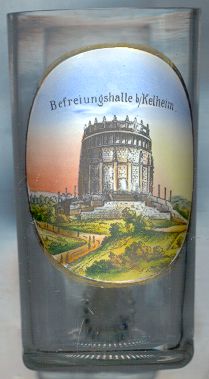

|
| DEUTSCHLAND | GERMANY |
| Bundesland: Freistaat Bayern | Bavaria |
| Regierungsbezirk: Niederbayern | |
| Landkreis: Kelheim |
Kelheim is situated at an elevation of 346 m at the river Danube at the mouth of the Altmühl river. The area has been inhabited already several thousand years ago. About 500 BC. Celtic settlers, built a fort on the Michelsberg. The name Kelheim has its origins in the Celtic word 'kel', which means cave. Their settlement may have been the second-largest Celtic settlement in Bavaria but disappeared when the Romans arrived. The Romans only built a small fort in the area (near Weltenburg). A Germanic settlement began to develop in Kehlheim between the 4th and 5th century. The first mention of Kelheim in document dates from 866 AD. (Campio nobilis Chrefting de Cheleheim). During that period at least two separate settlements existed: one (Oberkelheim) on the Michelsberg, and another (Gmünd) on the strip of land between the two rivers. A further village developed on the south bank of the Danube (Affecking, mentioned first in 878 AD. as Vekhinga). Today's old town originated after a castle was built on the island in the Danube (as early as the 10th century). The name of the counts residing in Kelheim was Schyren who were the ancestors of the Counts of Scheyern and thus also of the Wittelsbach dynasty. Otto of Wittelsbach was born in the castle of Kelheim in 1120 and became the first Wittelsbach Duke of Bavaria in 1180. His son, Duke Ludwig I (born 1173) is commonly known under the sobriquet "der Kelheimer". When Ludwig was assassinated in Kelheim in 1231, his son, Otto II, moved the residence to Landshut and later to Munich. The town was enlarged and fortified several times between the 13th and 17th centuries. Parts of the fortifications were pulled down in 1706 by Austrian forces during the War of the Spanish Succession.

The  Befreiungshalle (Liberation Hall) [left] on the
Michelsberg above the town is Kelheim's famous landmark. It was built by order of King Ludwig I
of Bavaria as a memorial to the wars of 1813–1815 against Napoleon. The architect Leo von Klenze
drew the designs for the monumental structure that took 21 years to be built (1842–1863).
The height of the rotunda is 45 m; together with the base and staircases it is 60 m.
The diameter of the main structure is 49 m; the entrance door (7 m high) was made out of
bronze of captured French canons. The interior walls of the hall are made of multicoloured marble,
the floor is ornated by a marble mosaic. The hall houses 34 Victory statues, each made of white
Carrara marble (each 3 m high), which were designed by the sculptor Ludwig Schwanthaler and
Max von Widnmann. The 34 statues represent the 34 states that formed the
German Confederation.
Befreiungshalle (Liberation Hall) [left] on the
Michelsberg above the town is Kelheim's famous landmark. It was built by order of King Ludwig I
of Bavaria as a memorial to the wars of 1813–1815 against Napoleon. The architect Leo von Klenze
drew the designs for the monumental structure that took 21 years to be built (1842–1863).
The height of the rotunda is 45 m; together with the base and staircases it is 60 m.
The diameter of the main structure is 49 m; the entrance door (7 m high) was made out of
bronze of captured French canons. The interior walls of the hall are made of multicoloured marble,
the floor is ornated by a marble mosaic. The hall houses 34 Victory statues, each made of white
Carrara marble (each 3 m high), which were designed by the sculptor Ludwig Schwanthaler and
Max von Widnmann. The 34 statues represent the 34 states that formed the
German Confederation.
The Befreiungshalle is also depicted on another glass from this collection,
no. 090, a souvenir from Regensburg.
|
![[scale]](lineal.jpg)